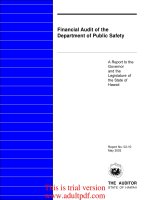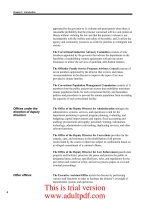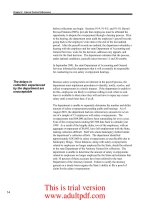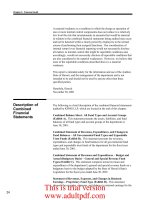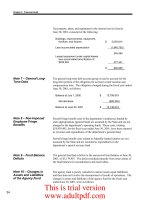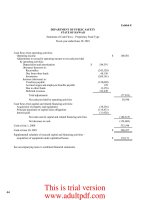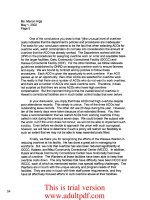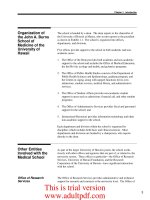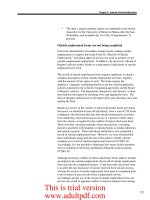Financial Audit of the John A. Burns School of Medicine of the University of Hawaii_part2 pptx
Bạn đang xem bản rút gọn của tài liệu. Xem và tải ngay bản đầy đủ của tài liệu tại đây (39.06 KB, 10 trang )
3
Chapter 1: Introduction
The school is headed by a dean. The dean reports to the chancellor of
the University of Hawaii at Manoa, who in turn reports to the president
as shown in Exhibit 1.1. The school is organized into offices,
departments, and divisions.
Five offices provide support to the school in both academic and non-
academic areas:
1. The Office of the Dean provides both academic and non-academic
support to the school and includes the Office of Medical Education,
the Imi Ho‘ola, ecology and health, and geriatrics programs;
2. The Office of Public Health Studies consists of the Department of
Public Health Sciences and Epidemiology, graduate program, and
the Center on Aging, along with support functions for its own
admissions, student services, medical library, and administrative
services;
3. The Office of Student Affairs provides non-academic student
support in areas such as admissions, financial aid, and other student
programs;
4. The Office of Administrative Services provides fiscal and personnel
support for the school; and
5. Instructional Resources provides information technology and other
non-academic support to the school.
Each department and division within the school is organized by
discipline, which includes both basic and clinical sciences. Most
departments and divisions are headed by a chairperson, who reports
directly to the dean.
As part of the larger University of Hawaii system, the school works
closely with other offices and agencies that are part of, or related to, the
university system. Three offices in particular—the Office of Research
Services, University of Hawaii Foundation, and the Research
Corporation of the University of Hawaii—have significant interaction
with the school.
The Office of Research Services provides administrative and technical
support for research and contracts at the university level. The Office of
Organization of
the John A. Burns
School of
Medicine of the
University of
Hawaii
Other Entities
Involved with the
Medical School
Office of Research
Services
This is trial version
www.adultpdf.com
4
Chapter 1: Introduction
Office of the Chancellor
University of Hawaii at Manoa
Office of the Dean
Office of Public
Health Studies
Department
of Family
Practice and
Community
Health
Department
of
Biochemistry
and
Biophysics
Department
of Medicine
Department
of Pathology
Department of
Pharmacology
Department
of Psychiatry
Department
of Tropical
Medicine and
Medical
Microbiology
Department
of Anatomy
and
Reproductive
Biology
Department
of Cell and
Molecular
Biology
Department
of Obstetrics,
Gynecology
and
Women's
Health
Department
of Pediatrics
Department
of
Physiology
Department
of Surgery
Admissions and
Student Services
Public Health and
Biomedical
Information
Center
Administrative
Services
Department of
Public Health
Sciences and
Epidemiology
Graduate
Program
Center on Aging
Office of
Student Affairs
Office of
Administrative
Services
Division of
Medical
Technology
Division of
Speech
Pathology and
Audiology
Exhibit 1.1
Organization Chart of the John A. Burns School of Medicine of the
University of Hawaii
Instructional
Resources
Allied Medical Sciences
Source: John A. Burns School of Medicine of the University of Hawaii.
This is trial version
www.adultpdf.com
5
Chapter 1: Introduction
Research Services is the focal point for submission of new, continuing,
and supplemental proposals, as well as for post-award administration,
including ensuring compliance with numerous federal and other
requirements. The Office of Research Services is also responsible for
billing and collecting funds generated by research projects, and works
closely with the medical school.
The Office of Research Services also performs reviews of non-research
related contracts and other agreements for compliance with university
administrative requirements, and executes such contracts and agreements
on behalf of the school.
The University of Hawaii Foundation is a private, non-profit corporation
designated by the Internal Revenue Service as a 501(c)(3) organization.
The University of Hawaii Foundation is the central fundraising agency
for the university. It conducts campaigns for university priorities and
provides central services to raise funds, manage assets, and administer
gift accounts for the university. Its mission is to advance the university’s
goals by raising and stewarding gifts, including those for the medical
school.
The Research Corporation of the University of Hawaii is a state agency,
established by the Legislature in 1965, and attached to the university for
administrative purposes. The fundamental mission of the Research
Corporation of the University of Hawaii is to support research and
training programs of the university and to enhance research,
development, and training in Hawaii. The corporation is similar to a
service bureau, in that it hires personnel and procures goods and services
on behalf of its clients, the university being its major client.
Because of its exemption from state statutes such as those relating to
procurement and personnel, the corporation has the flexibility to function
more like a business. Accordingly, the corporation has its own
personnel, payroll, accounting, and disbursing systems, independent of
the state and university systems. This makes it possible for the
corporation to process transactions expeditiously, which in turn makes it
possible for researchers to focus more of their efforts on research rather
than administrative activities. The university pays an administrative fee
to the corporation based on the volume of services provided.
1. To assess the adequacy, effectiveness, and efficiency of the systems
and procedures for the financial accounting, internal control, and
financial reporting of the John A. Burns School of Medicine of the
University of Hawaii
Foundation
Research Corporation
of the University of
Hawaii
Objectives of the
Audit
This is trial version
www.adultpdf.com
6
Chapter 1: Introduction
University of Hawaii; to recommend improvements to such systems,
procedures, and reports; and to report on the financial statements of
the school.
2. To ascertain whether expenditures or deductions and other
disbursements have been made and all revenues or additions and
other receipts have been collected and accounted for in accordance
with federal and state laws, rules and regulations, and policies and
procedures.
3. To make recommendations as appropriate.
We audited the school’s financial records and transactions and reviewed
its related systems of accounting and internal controls for the fiscal year
July 1, 2001 to June 30, 2002. We tested financial data to provide a
basis from which to report on the fairness of the presentation of the
financial statements. We also reviewed the school’s transactions,
systems, and procedures for compliance with applicable laws,
regulations, and contracts.
We examined the school’s existing accounting, reporting, and internal
control structures and identified deficiencies and weaknesses therein.
We made recommendations for appropriate improvements including, but
not limited to, the school’s administration of contracts and compliance
with policies and procedures relating to conflicts of interest.
In addition, we reviewed the extent to which recommendations made in
the school’s previous external financial audits and agreed-upon
procedures reports have been implemented. Where recommendations
have not been, or have been only partially, implemented, the reasons for
these were evaluated.
The independent auditors’ opinion as to the fairness of the school’s
financial statements presented in Chapter 3 is that of Deloitte & Touche
LLP. The audit was conducted from July 2002 through October 2002 in
accordance with generally accepted government auditing standards.
Scope and
Methodology
This is trial version
www.adultpdf.com
7
Chapter 2: Internal Control Deficiencies
Chapter 2
Internal Control Deficiencies
Internal controls are steps instituted by management to ensure that
objectives are met and resources are safeguarded. This chapter
presents our findings and recommendations on the financial accounting
and internal control practices and procedures of the John A. Burns
School of Medicine of the University of Hawaii (school).
1. The administration and management of the John A. Burns School of
Medicine of the University of Hawaii’s contracts with health care
organizations to provide training and medical services are deficient.
As a result, the school provided services for at least four months
without the protection of signed contracts and incurred
approximately $2.3 million in expenses before the health care
organizations could be billed for services provided. In addition, the
school is delinquent in its final reconciliations of its contracts.
These deficiencies are primarily the result of untimely planning and
inefficient processes.
2. The school does not comply with certain university policies and
procedures regarding conflict of interest situations involving school
faculty. As a result, conflict of interest situations may not be
identified or adequately resolved. These situations may jeopardize a
faculty member’s ability to perform his or her duties and
responsibilities to the school, and any resulting negative publicity
may undermine the public’s confidence in the school. The primary
cause of this noncompliance is the lack of enforcement of
established monitoring programs due to the school administration’s
failure to take seriously the consequences of failing to disclose a
conflict of interest situation.
The administration and management of the medical school’s contracts
with health care organizations are deficient. Because the school does not
have a teaching hospital, it contracts with various health care
organizations to provide training and medical services to its students in a
clinical setting. These contracts require the organizations to reimburse
the school for salary, fringe benefit, and professional malpractice
insurance premium costs of faculty providing medical services for the
respective organizations while conducting training. We found that
contracts are not executed in a timely manner, the resulting delays in
Summary of
Findings
The
Administration
and Management
of Contracts Are
Deficient
This is trial version
www.adultpdf.com
8
Chapter 2: Internal Control Deficiencies
contract execution negatively impact the school’s cash flow, and final
contract reconciliations are not performed in a timely manner. These
deficiencies result from poor planning and inefficient processes.
The school has numerous contracts with federal, state, and private
agencies to provide research, training, and medical services. Normally,
the university’s Office of Research Services and Office of General
Counsel assist the university’s departments or divisions with drafting or
reviewing contracts to ensure compliance with laws, rules, regulations,
and university administrative policies and procedures. However,
because of the specialized nature of salary and fringe benefit agreements
that the school has with various health care organizations, the school
retains primary responsibility for the contracts. For these contracts, the
Office of Research’s and Office of General Counsel’s involvement is
normally limited to providing assistance on an as-needed basis, such as
in the event significant changes are required to be made to the contract
terms.
The departments and divisions of the school are responsible for
negotiating the applicable scope of services to be rendered, timing of
services, and amount of fees to be charged. Fees are normally set at
amounts approximating salary and fringe benefits to be paid to the
particular faculty members covered under the contracts. However, such
fees are often subject to negotiation with the health care organizations,
especially if the amounts exceed the organizations’ budgeted amounts.
These negotiations can often be time-consuming. Once the negotiations
are finalized, the Office of Research Services executes the contracts on
behalf of the school.
Contracts are not executed in a timely manner
We examined all 28 contracts that the school had with health care
organizations during FY2001-02 for salary and fringe benefit
reimbursements for services rendered by school faculty. We found that
in every instance, services had commenced prior to contract execution.
In almost all cases, the school submitted the contracts to the health care
organizations for their review and execution about 30 days before the
start of the service period. However, we calculated that, on average, the
health care organizations took about 113 days to perform their review of
the contracts, and the school took another 32 days to finalize the
contracts. Thus, the school provided services to the health care
organizations for an average of four months prior to contract execution.
Contract delays negatively impact the school
The school cannot bill for services rendered by its faculty without a
properly executed contract. Accordingly, in the case of salary and fringe
The school is
responsible for
contract negotiation
and execution
This is trial version
www.adultpdf.com
9
Chapter 2: Internal Control Deficiencies
benefit contracts with health care organizations, the school incurred—
and paid out of its general funds—expenses for approximately four
months before it could bill for these services and receive reimbursement.
With an average monthly billing of $587,000 for medical services,
approximately $2.3 million of services were provided by the school
before bills could be sent. This situation negatively impacts the school’s
cash flow. Funds that should be available to the school remain
outstanding for several months and interest income on the amounts
outstanding is lost. The health care organizations, on the other hand,
have the benefit of using or investing the cash during the period.
In addition, the lack of an executed contract exposes the school to
potential disagreements with health care organizations about the nature,
extent, and timing of medical services, and the amount of reimbursement
it is to receive. Although the school attempts to obtain either written or
verbal authorization from the health care organizations to continue
services at an agreed-upon level during the contract-negotiation period, it
is nevertheless a poor business practice to perform services without an
executed contract in place; and furthermore, it exposes the school to
unnecessary legal risk.
Final reconciliations are not performed on a timely basis
The school bills the health care organizations an estimated monthly
amount, which is computed as one-twelfth of the contract amount. At
fiscal year-end, a reconciliation is performed to determine the actual
costs incurred for the individuals covered under the salary and fringe
benefit agreements. Any adjustments from the estimated amount to the
actual amount are incorporated into the final bill. As of the date of our
testing in mid-October 2002, the school still had not completed all of its
final reconciliations for FY2001-02, and accordingly, still had not sent
out its final bills that would cover the final month of service, as well as
any necessary adjustments. As a result, the school was unable to access
these funds for over three months and lost any potential interest that
could have been earned on the money during the period.
Delays in the execution of contracts and performance of final
reconciliations are primarily the result of untimely planning and
inefficient processes. Salary and fringe benefit agreements with health
care organizations are, for the most part, renewed annually with few or
no changes to the language in the agreement. However, the budget
schedules, which are included as attachments to the contract and which
list the covered faculty and their respective salary and fringe benefit
amounts, change from year to year. Although the school begins the
process of accumulating budget information within 90 days prior to the
commencement date of the contracts, past experience indicates that this
Poor planning and
inefficient processes
delay contract
execution and
administration
This is trial version
www.adultpdf.com
10
Chapter 2: Internal Control Deficiencies
timing is insufficient to negotiate the terms of the contracts with the
health care organizations and to finalize the contracts prior to the
required start date for the provision of services. This situation clearly
reflects the school’s poor planning in ensuring the timely execution of
the contracts.
In addition, there are inefficiencies in the way the final contract
reconciliations are processed. The data accumulation required for the
reconciliation is performed manually, and requires a significant amount
of resources to compile.
The school should revise its planning for contract negotiations by
allowing more time for contract negotiation and execution, such that
services commence only after the contracts have been finalized and
executed. In addition, the school should review the process used to
prepare the final contract reconciliations to ensure that the final bills are
sent out in a timely manner.
The university has policies and procedures relating to various personnel
matters, including those pertaining to conflict of interest situations
involving faculty employment. We found that the school did not comply
with many of these conflict of interest policies and procedures.
University faculty are encouraged to promote the state’s cultural and
economic development by utilizing their special abilities and skills in
research, teaching, or other areas over and above their university
positions. However, the Board of Regents’ policies and the University of
Hawaii Professional Assembly collective bargaining agreement include
limits on such outside employment to ensure that they do not interfere
with the faculty’s primary obligation to the university.
The university executive policy regarding conflicts of interest notes that
“a potential or actual conflict of interest exists when commitments and
obligations to the university are likely to be compromised by a person’s
other interests or commitments, particularly if those interests or
commitments are not disclosed.”
Recommendations
The School Does
Not Comply with
University of
Hawaii Policies
and Procedures
Regarding Conflict
of Interest
Situations
Conflict of interest
situations may not be
identified or adequately
resolved
This is trial version
www.adultpdf.com
11
Chapter 2: Internal Control Deficiencies
The university monitors potential conflicts of interest by requiring its
faculty members to submit disclosure forms and outside employment
forms. We found that, out of a total of 419 school employees involved in
either teaching or research, 49, or 12 percent, had not completed the
forms. Accordingly, potential conflict of interest situations could exist
without timely detection.
These conflict of interest situations may jeopardize a faculty member’s
ability to carry out his or her duties and responsibilities to the school. In
addition, any negative publicity relating to the existence of such conflict
of interest situations could undermine the public’s confidence in the
university and the school.
Disclosure forms are not submitted in a timely manner
University executive policy requires faculty, certain staff, and
administrators to complete a university disclosure form and to submit it
to their supervisor (respective department chairperson, unit director, or
dean) by April 15 of each year. Part I of the form requires disclosure of:
• Whether the individual has any ownership interests in any
organization in his or her field;
• Whether the individual held any officer or other positions in any
organization;
• Whether the individual received income from an outside source;
• Whether the individual employed students or staff outside the
university; and
• The existence of other transactions or facts.
Any affirmative responses in Part I of the form require completion of
Part II of the form. Part II then requires specific information regarding
the ownership, position, or activity described. The form must be
reviewed and signed by the individual’s supervisor, who certifies that, to
his or her knowledge, the individual either does not have any conflicts of
interest, or has reported and resolved any existing conflicts. Any
conflicts of interest that cannot be resolved by the individual’s
supervisor must be taken to the next higher level of administration.
While university policy describes procedures for gathering information
regarding potential conflicts of interest, it does not provide guidance on
procedures for resolving conflicts of interest.
Department chairpersons or unit directors must compile an annual report
summarizing the data on disclosure forms for their respective
This is trial version
www.adultpdf.com
12
Chapter 2: Internal Control Deficiencies
departments or units, and submit it to the dean by April 15 of each year.
The summary report includes the following information about the
employees reporting to them:
• The number and percentage who filled out the form;
• The number and percentage who answered questions in Part I
affirmatively;
• The number and percentage who completed Part II;
• The number and percentage whose conflicts of interest were
resolved;
• The number and percentage whose conflicts of interest were not
resolved; and
• Details of recommended actions to resolve any outstanding
conflicts of interest.
The dean must submit to the chancellor an annual summary for the entire
school by June 30 of each year.
To test compliance with this policy, we examined 127 individual
disclosure forms and noted the following discrepancies:
• 44 forms (35 percent) were signed by employees after the April
15 deadline. Of these, five forms were completed after we
requested access to the forms during our fieldwork in September
2002; and
• 65 forms (51 percent) were not reviewed or approved by a
supervisor before the April 15 deadline, and forms for all nine
individuals in one department remained unsigned through
September 2002.
We also examined departmental annual summary reports and noted the
following discrepancies:
• 17 of the 33 departments (52 percent) did not prepare the annual
summary report;
• Five of the 33 departments (15 percent) prepared their annual
summary reports after the April 15 deadline;
• 15 of the 28 supervisors (54 percent) who report directly to the
dean did not submit their individual disclosure forms to the dean;
and
This is trial version
www.adultpdf.com
